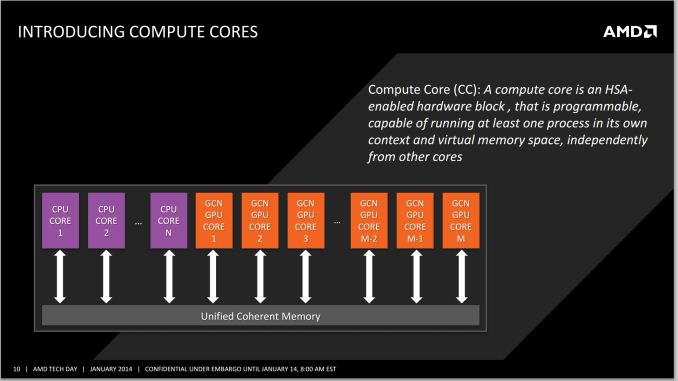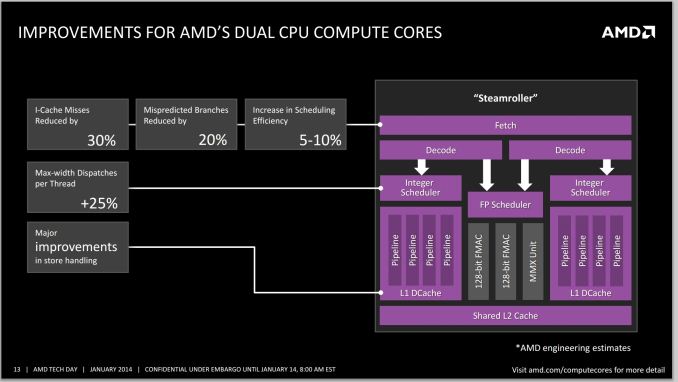AMD Kaveri Review: A8-7600 and A10-7850K Tested
by Ian Cutress & Rahul Garg on January 14, 2014 8:00 AM ESTKaveri and Counting Cores
With the move towards highly integrated SoCs we've seen a variety of approaches to core counts. Apple, Intel and Qualcomm still count CPU cores when advertising an SoC. For Apple and Qualcomm that's partially because neither company is particularly fond of disclosing the configuration of their GPUs. More recently, NVIDIA took the somewhat insane stance of counting GPU CUDA cores on its Tegra K1 SoC. Motorola on the other hand opted for the bizarre choice of aggregating CPU, GPU and off-die companion processors with the X8 platform in its Moto X smartphone. Eventually we will have to find a way to characterize these highly integrated SoCs, particularly when the majority of applications actually depend on/leverage both CPU and GPU cores.
AMD finds itself in a unique position with Kaveri where it has a truly unified CPU/GPU architecture and needs to establish a new nomenclature for use in the future. With 47% of the Kaveri die dedicated for GPU use, and an architecture that treats both CPU and GPU as equals, I can understand AMD's desire to talk about the number of total cores on the APU.
AMD settled on the term "Compute Core", which can refer to either an x86 (or maybe eventually ARM) CPU core or a GCN compute unit. The breakdown is as follows:
- Each thread on a CPU is a Compute Core
- Each Compute Unit on the IGP is a Compute Core
- Total Compute Cores = CPU Compute Cores + IGP Compute Cores
This means that the high end SKU, the A10-7850K will have a total of 12 compute cores: four from the CPU (two Steamroller modules supporting four threads) and eight from the IGP (due to eight compute units from the R7 graphics).
There are some qualifications to be made on this front. Technically, AMD is correct – each compute unit in the IGP and each thread on the CPU can run separate code. The Hawaii GCN architecture can spawn as many kernels as compute units, whereas a couple of generations ago we were restricted to one compute kernel on the GPU at once (merely with blocks of work being split across the CUs). However, clearly these 12 compute units are not equivalent: a programmer will still have to write code for the CPU and GPU specifically in order to use all the processing power available.
Whenever AMD (or partners) are to promote the new APUs, AMD tells us clearly that two sets of numbers should be quoted in reference to the Compute Cores – the total, and the breakdown of CPU/GPU on the APU. Thus this would mean that the A10-7850K APU would be marketed at a “12 Compute Core” device, with “(4 CPU + 8 GPU)” following immediately after. I applaud AMD's decision to not obfuscate the internal configuration of its APUs. This approach seems to be the most sensible if it wants to tout the total processing power of the APU as well as tell those users who understand a bit more what the actual configuration of the SoC is. The biggest issue is how to address the users who automatically assume that more cores == better. The root of this problem is very similar to the old PR-rating debates of the Athlon XP. Explaining to end users the intracacies of CPU/GPU programming is really no different than explaining why IPC * frequency matters more than absolute frequency.
When a programmer obtains an APU, the OpenCL profiler should locate the eight compute units of the GPU and display that to the user for offloading compute purposes; at the same time it is up to the programmer to leverage the threads as appropriately as possible, even with AMD’s 3rd generation Bulldozer modules implementing a dual-INT + single-FP solution.
At launch, AMD will offer the following configurations:
- A10-7850K: 12 Compute Cores (4 CPU + 8 GPU)
- A10-7700K: 10 Compute Cores (4 CPU + 6 GPU)
- A8-7600: 10 Compute Cores (4 CPU + 6 GPU)
The problem with distilling the processing power of the APU into a number of compute cores is primarily on the CPU side. AMD will be keeping the GPU at approximately the same clock (720 MHz for these three) but the CPU frequency will differ greatly, especially with the A8-7600 which has configurable TDP and when in 45W mode will operate 300-400 MHz less.
Steamroller Architecture Redux
We've already documented much of what Steamroller brings to the table based on AMD's Hot Chips presentation last year, but I'll offer a quick recap here.
Steamroller brings forward AMD's Bulldozer architecture, largely unchanged. We're still talking about a dual-core module featuring two independent integer execution cores with a single shared floating point execution core capable of executing instructions from two threads in parallel. A single module still appears as two cores/threads to the OS.
In Bulldozer and Piledriver, each integer core had its own independent scheduler but the two cores shared a single fetch and decode unit. Instructions would come in and decodeded operations would be fed to each integer pipe on alternating clock cycles. In Steamroller the decode hardware is duplicated in each module, so now each integer core gets its own decode unit. The two decode units are shared by the one FP unit.
L1 instruction caches increase in size from 64KB to 96KB per module, which AMD claims reduces misses by up to 30%. There's an updated branch predictor which is responsible for reducing mispredicted branches by up to 20%. Both integer and FP register files grow in size as well as an increase in the size of the scheduling window, a combination of which increases the number of dispatches per thread by up to 25%.
There are huge improvements on the store side. Steamroller can now issue up to 2 stores at the same time compared to 1 in Bulldozer/Piledriver. The load/store queue sizes go up by around 20% as well. It's remarkable just how much low hanging fruit there was in the Bulldozer design.
GCN in an APU
The integrated graphics solution on Trinity/Richland launched with a Cayman-derived VLIW4 architecture, which unfortunately came just shortly after desktop side of the equation finished moving from VLIW5/VLIW4 to GCN. Having a product stack with largely different GPU architectures doesn't help anyone, particularly on the developer front. Looking forward, sticking with GCN was the appropriate thing to do, as now Kaveri is using GCN, the same architecture found in AMD’s high end R9-290X GPU, based on the Hawaii platform.
This enabled AMD to add in all the features they currently have on Hawaii with little to no effort – the TrueAudio DSP, the upgraded Video Coding Engine and Unified Video Decoder are such examples. Whether or not AMD decides to develop an APU with more than 8 GCN CUs is another matter. This is a point we've brought up with AMD internally and one that I'm curious about - do any AnandTech readers have an interest in an even higher end APU with substantially more graphics horsepower? Memory bandwidth obviously becomes an issue, but the real question is how valuable an Xbox One/PS4-like APU would be to the community.














380 Comments
View All Comments
fteoath64 - Sunday, January 19, 2014 - link
"Now we need a new one, a fully HSA compliant HyperTransport." Yes! The dedicated people working on new SuperComputers are doing exotic Interconnects close or exceeding 1TBytes/sec speeds but limited by distance naturally. I see that for HyperTransport 3.0 one can implement 10 channels for high aggregated bandwidth, but that will use more transistors. In a budget conscious die size, using eSRAM seems to be a good trick to boost the bandwidth without overt complexity or transistor budget. The downside is eSRAM suck constant power so it becomes a fixture in the TDP numbers. Iris PRO uses 128MB of eDRAM while Xbox One uses 32MB eSRAM. I think the least amount would be somewhere around 24MB for the x86 to be effective in getting effective RAM bandwidth high enough!.The cascading effect if that the memory controller becomes complex and eats into the transistor budget considerably. Seems like a series of moving compromises to get the required performance numbers vs power budget for TDP.
I am actually very excited to see an Arm chip implementing HSA!!.
Samus - Wednesday, January 15, 2014 - link
I don't get why AMD can't compete with Intel's compute performance like they were absolutely able to do a decade ago. Have they lost all their engineering talent? This isn't just a matter of the Intel manufacturing/fab advantage.zodiacfml - Wednesday, January 15, 2014 - link
oh no, after all that, I just came impressed with the Iris Pro. I believe memory bandwidth is needed for Kaveri to stretch its legs.duploxxx - Wednesday, January 15, 2014 - link
impressed with iris pro? for that price difference i would buy a mediocore CPU and dedicated GPU and run circles around it with any game....oaf_king - Wednesday, January 15, 2014 - link
I can point out some carpola here: "I am not sure if this is an effect of the platform or the motherboard, but it will be something to inspect in our motherboard reviews going forward." This sure discounts the major performance benefits you can achieve without faulty hardware. Search the real benchmarks on WCCF tech for A-10 7850 and be amazed. I can STRONGLY DOUBT the CPU has any issue running at 4ghz on a stock cooler/900mhz GPU. Yes the GPU overclock seems skipped over in this Anand review also, but should really pull it into the "useful" category for gaming!oaf_king - Wednesday, January 15, 2014 - link
recall AMD had some leaks suggesting 4ghz CPU / 900Mhz GPU. Is that possible after all? Apparently not all motherboards are faulty. If the TDP tops out at 148 at 4ghz, given the conservative power envelopes already placed on the chip, I'm sure it gets very good performance for between zero and ten extra dollars, and a couple seconds in the BIOS.Fox McCloud - Wednesday, January 15, 2014 - link
Maybe I was skim reading and missed it, but what are the idle power consumption figures for the A8-7600? I need a new home server and I have a iTX system, and mother boards with 6x SATA are slim. It seems the manufacturers only put them on AMD ITX boards, as Intel seem to max out at like 4. I wonder what power figures would be like if under clocked also. I might re-read the review!Excellent review as always guys. So in-depth, informative, technical and unbiased. This is why I love this site and trust your expert opinion :)
Zingam - Wednesday, January 15, 2014 - link
AMDs PR: "The processor that your grandparents dream of!" FYEAHA!keveazy - Wednesday, January 15, 2014 - link
My i5 4440 costs the same as the a10-7850k. I don't think amd will ever compete. By the time they release something that would declare a significant jump, Intel would already have something new to destroy it by then.duploxxx - Wednesday, January 15, 2014 - link
compete to do what? general tasks in a day, just buy an SSD... cost? did check your motherboard price? GPU, did you check the 4600 performance vs a10? it runs circles around it unless you want to be stuck on low resolution with your gorgeous fast cpu.you see customers fool themselve not knowing what to buy for what. hey i have the best benchmarking cpu, but on daily tasks i can't even count the microseconds difference.